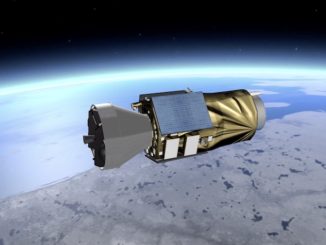
Loaded with three commercial satellites, a European Ariane 5 rocket returned to its launch pad in French Guiana Thursday after a two-week launch delay to resolve a technical issue that forced an abort to a countdown July 31. Arianespace says the mission has been rescheduled for launch Saturday due to unfavorable upper level winds in the forecast for Friday.
The 179-foot-tall (54.8-meter) rocket rolled out of its final assembly building at the Guiana Space Center Thursday for the trip to the ELA-3 launch zone. Riding a mobile launch platform, the rocket was tugged by a diesel-powered Titan tug for the 1.7-mile (2.7-kilometer) journey.
Arianespace, the French company responsible for selling and launching Ariane 5 rockets, planned to send the launch vehicle into orbit July 31 with three U.S.-made satellites. But a suspect reading from a sensor on the Ariane 5’s first stage liquid hydrogen tank stopped the countdown around two minutes prior to liftoff.
Ground crews returned the rocket to the final assembly building for troubleshooting. With the problem resolved, Arianespace rolled the rocket back to the launch pad Thursday ahead a planned countdown Friday.
But Arianespace said late Thursday that unfavorable high-altitude winds were predicted Friday, prompting a delay in the launch to Saturday.
The 47-minute launch window Saturday opens at 5:33 p.m. EDT (2133 GMT; 6:33 p.m. French Guiana time).
The launch will be the first by Arianespace since the onset of the coronavirus pandemic forced a cessation in launch preparations at the European-run spaceport in French Guiana in March. Work on launch campaigns partially resumed in May, and Arianespace planned to launch a light-class, solid-fueled Vega rocket in late June with a cluster of 53 small satellites.
But a stretch of persistently unacceptable upper level winds kept the mission from launching, and engineers needed to recharge batteries on the rocket and on some of the mission’s small satellite payloads. Arianespace officials then turned their attention to the next Ariane 5 rocket on the company’s launch schedule.
Assuming the Ariane 5 rocket takes off this weekend, Arianespace will again try to launch the Vega rocket’s small satellite rideshare mission around Aug. 31.
The Ariane 5 rocket is slated to launch with a pair of U.S.-built communications satellites and Northrop Grumman’s second Mission Extension Vehicle, a spacecraft designed to dock with other satellites in geostationary orbit, a belt located more than 22,000 miles (nearly 36,000 kilometers) over the equator.
The mission will be the first Ariane 5 flight to carry three multi-ton geostationary satellites on a single mission. The Ariane 5 rocket typically launches with two large geostationary payloads on commercial flights.
The MEV-2 and Intelsat’s Galaxy 30 communications satellite are connected together inside the upper berth of the Ariane 5’s voluminous payload fairing. Both satellites were built by Northrop Grumman in Dulles, Virginia.
Galaxy 30 will provide commercial video and television broadcast services over North America, and also hosts a navigation augmentation payload for the Federal Aviation Administration. After launch and reaching geostationary orbit, MEV-2 will autonomously dock with the Intelsat 10-02 communications satellite — which is low on fuel — and take over propulsion duties, extending the spacecraft’s useful life.
The BSAT-4b satellite launching in the lower position inside the Ariane 5 fairing was built by Maxar in Palo Alto, California. Owned by the Japanese operator B-SAT, the BSAT-4b satellite will be positioned over the Asia-Pacific to provide direct-to-home television broadcast services.
The Ariane 5 rocket set to launch the three geostationary satellites is also testing several upgrades, including modified pressure vents on its payload fairing. Engineers will gather data on the changed vent configuration to ensure it meets stringent requirements for the launch of the $10 billion James Webb Space Telescope on an Ariane 5 rocket next year.
The launch vehicle also has a lighter vehicle equipment bay, a part of the rocket that contains the Ariane 5’s avionics and guidance systems. That increases the Ariane 5’s lift capability by about 187 pounds, or 85 kilograms, according to Arianespace.
And the Ariane 5 is testing a new autonomous location system, which will eventually be used operationally on Europe’s next-generation Ariane 6 rocket. The autonomous system will use signals from Europe’s Galileo navigation satellites to determine the rocket’s location, streamlining range safety requirements, which currently rely on extensive ground infrastructure, such as radars, to track rockets as they depart the Guiana Space Center.
Email the author.
Follow Stephen Clark on Twitter: @StephenClark1.



